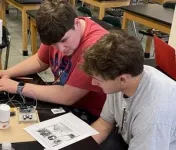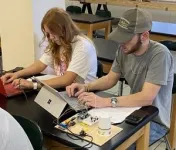(Press-News.org) By John Lovett
University of Arkansas System Division of Agriculture
FAYETTEVILLE, Ark. — Artificial intelligence tools such as ChatGPT show promise as a useful means in agriculture to write simple computer programs for microcontrollers, according to a study published this month.
Microcontrollers are small computers that can perform tasks based on custom computer programs. They receive inputs from sensors and can be used in climate and irrigation controls, food processing systems, as well as robotic and drone applications, to name a few agricultural uses.
A recent study published with the Arkansas Agricultural Experiment Station and the Dale Bumpers College of Agricultural, Food and Life Sciences showed agriculture students who were unfamiliar with computer coding were able to a program a microcontroller to perform a simple task using ChatGPT.
“Generative AI can make a big impact on agriculture … I can’t see how it wouldn’t,” said Don Johnson, University Professor of agricultural education, communications and technology and the lead researcher on the project. “We need to prepare our graduates to be a part of that.”
“Generative” refers to the tool’s ability to create content.
Johnson’s latest study on the topic, titled “Agriculture students’ use of generative artificial intelligence for microcontroller programming,” was published in the Natural Sciences Education journal in August. Co-authors included Bumpers College faculty members in the agricultural education, communications and technology department, Will Doss, assistant professor, and Christopher Estepp, associate professor.
Johnson said computer programming has typically not been taught in most undergraduate agriculture majors, but the inclusion of microcontrollers as components of agricultural equipment and systems has become more common. While there will always be a demand for individuals who have deep expertise in computer programming, Johnson explained the focus of these studies has been to explore how people without deep expertise can use microcontrollers in their academic and professional careers.
Johnson conducts research on human capital development and agricultural technologies for the experiment station, the research arm of the University of Arkansas System Division of Agriculture.
“I think what we’ve established is that ag students can use generative artificial intelligence to write code to solve moderately difficult programming problems without any deep knowledge of programming,” Johnson said.
Study origins
Johnson began investigating the topic of AI-assisted programming in 2022 when ChatGPT was released and learned that it could write code for microcontrollers like Arduinos. He conducted a preliminary study not long afterward comparing the abilities, interest and confidence between two groups of undergraduate agriculture students as they programmed a microcontroller to blink two LEDs in a particular sequence. One group of students wrote their own programs while the other group used ChatGPT.
The results indicated students writing their own programs developed grater Arduino programming confidence and ability than novice students using ChatGPT. However, both groups had the same level of success and interest in learning more about the microcontrollers and coding.
The follow-up study published in August was conducted solely with undergraduate agricultural students without significant computer programming experience. The study aimed to determine the confidence in their ability to use ChatGPT to write Arduino code for a more advanced problem than in the first study. This second study required students to use ChatGPT to program the Arduino to turn on a transfer pump when the level of solution in a heating tank fell 8 inches or more below a sensor and then turn the pump off when the tank refilled to within 3 inches of the sensor.
“You would need some degree of sophistication in programming to write a code for this problem in the second study, and none of these students did,” Johnson said. “But they were successful. Nine of the 11 two-person teams were successful in getting the code to do exactly what it was supposed do.”
ChatGPT coaching in both studies involved informing the students what made a good prompt for the generative AI platform. A good prompt, Johnson explained, would clearly describe the situation, components and connections, and the desired outcome.
Going a step further
Johnson would like to take the experiment one step further by leaving the problem open-ended — let students come up with their own scenarios and use ChatGPT to write the code for a microcontroller.
“I want to give students the confidence to approach microcontrollers in a problem-solving orientation and say ‘Yes, I can use this tool to solve my problem,” Johnson said.
To learn more about the Division of Agriculture research, visit the Arkansas Agricultural Experiment Station website. Follow us on X at @ArkAgResearch, subscribe to the Food, Farms and Forests podcast and sign up for our monthly newsletter, the Arkansas Agricultural Research Report. To learn more about the Division of Agriculture, visit uada.edu. Follow us on X at @AgInArk. To learn about extension programs in Arkansas, contact your local Cooperative Extension Service agent or visit uaex.uada.edu.
About the Division of Agriculture
The University of Arkansas System Division of Agriculture’s mission is to strengthen agriculture, communities, and families by connecting trusted research to the adoption of best practices. Through the Agricultural Experiment Station and the Cooperative Extension Service, the Division of Agriculture conducts research and extension work within the nation’s historic land grant education system.
The Division of Agriculture is one of 20 entities within the University of Arkansas System. It has offices in all 75 counties in Arkansas and faculty on five system campuses.
The University of Arkansas System Division of Agriculture offers all its Extension and Research programs and services without regard to race, color, sex, gender identity, sexual orientation, national origin, religion, age, disability, marital or veteran status, genetic information, or any other legally protected status, and is an Affirmative Action/Equal Opportunity Employer.
END
Study shows successful use of ChatGPT in ag education
Microcontrollers are common in agriculture but computer programming classes are not
2024-08-21
ELSE PRESS RELEASES FROM THIS DATE:
Early interventions may improve long-term academic achievement in young childhood brain tumor survivors
2024-08-21
(MEMPHIS, Tenn. – August 20, 2024) Children who survive a brain tumor often experience effects from both the cancer and its treatment long after therapy concludes. Scientists at St. Jude Children’s Research Hospital found very young children treated for brain tumors were less prepared for school (represented by lower academic readiness scores) compared to their peers. This gap persisted once survivors entered formal schooling. Children from families of higher socioeconomic status were partially protected from the effect, suggesting that providing early developmental resources may proactively help reduce the academic achievement gap. The findings were published today in ...
Cholecystectomy not always necessary for gallstones and abdominal pain
2024-08-21
Each year, 100,000 people visit their doctor with abdominal pain, with approximately 30,000 of them diagnosed with gallstones. The standard treatment for these patients is a laparoscopic cholecystectomy. Since the 1990s, the number of surgeries has increased exponentially, despite the lack of clear international criteria. As a result, gallbladder removal is one of the most common surgeries in the Netherlands, yet it is not always effective against pain: about one-third of patients continue to experience abdominal pain after cholecystectomy. The procedure has long been an example of inappropriate care, but this is now changing.
In a 2019 study conducted by Radboud university ...
Greenhouse gas HFC-23: Abatement of emissions is achievable
2024-08-21
Hydrofluorocarbons (HFCs) are potent greenhouse gases (GHGs). The most potent of these compounds is trifluoromethane, also known as HFC-23. One kilogram of HFC-23 in the atmosphere contributes as much to the greenhouse effect as 12,000 kilograms of CO₂. It takes around 200 years for the gas to break down in the atmosphere. For this reason, more than 150 countries have committed to significantly reducing their emissions of HFC-23 as part of the Kigali Amendment to the Montreal Protocol.
The main source of HFC-23 ...
Researchers identify most common long COVID symptoms in children and teens
2024-08-21
Aug. 21, 2024--Researchers from the NIH’s RECOVER Initiative have determined what long COVID looks like in youths, based on the most common symptoms reported in a study of over 5,300 school-age children and adolescents.
Using the findings, published today in the Journal of the American Medical Association, the researchers also created indices that contain prolonged symptoms—eight for school-age children and 10 for adolescents—that together most likely indicate long COVID.
The indices are not intended to be used in making a clinical diagnosis of long COVID but will guide research to improve diagnosis, treatment, and prevention of the condition in youths.
“Many ...
NIH-funded study finds long COVID affects adolescents differently than younger children
2024-08-21
NIH-funded study finds long COVID affects adolescents differently than younger children Adolescents were most likely to experience low energy/tiredness while children were most likely to report headache
Scientists investigating long COVID in youth found similar but distinguishable patterns between school-age children (ages 6-11 years) and adolescents (ages 12-17 years) and identified their most common symptoms. The study, supported by the National Institutes of Health (NIH) and published in JAMA, comes from research conducted through the NIH’s Researching ...
Characterizing long COVID in children and adolescents
2024-08-21
About The Study: In this large-scale study, symptoms that characterized pediatric postacute sequelae of SARS-CoV-2 infection (PASC), or long COVID, differed by age group, and several distinct phenotypic PASC presentations were described. The research indices developed here will help researchers identify children and adolescents with high likelihood of PASC. Although these indices will require further research and validation, this work provides an important step toward a clinically useful tool for diagnosis with the ultimate goal of supporting optimal care for youth with PASC.
Quote from corresponding author Rachel ...
Researchers aim to pull back the curtain on long COVID in kids
2024-08-21
The kids were correct all along.
In the most comprehensive national study since the onset of the COVID-19 pandemic, a team of researchers that includes a Rutgers-organized consortium of pediatric sites has concluded that long COVID symptoms in children are tangible, pervasive, wide ranging and clinically distinct within specific age groups.
Results of the study, funded by the National Institutes of Health (NIH), are published in the Journal of the American Medical Association.
“We have convincing evidence that COVID-19 is not just a mild, benign illness for children,” ...
RECOVER study determines most common long COVID symptoms in children and teens
2024-08-21
A research team led by the National Institutes of Health’s RECOVER Initiative and supported by its Clinical Science Core (CSC) at NYU Langone Health, has designed a new way to identify which school-age children and adolescents most likely have Long COVID.
Solely for the purpose of further study and not for use in clinical diagnoses, the team’s new measure (index) identifies children and teens with the highest chances of having Long COVID. The research index is based on long-term symptoms ...
UCLA-led study unveils new insights and potential treatments for pulmonary hypertension
2024-08-21
A new study from researchers with UCLA Health and collaborating organizations has found that asporin, a protein encoded by the ASPN gene, plays a protective role in pulmonary arterial hypertension (PAH).
Their findings, published on August 21 in the peer-reviewed journal Circulation, offer new insights into this incurable, often-fatal disease and suggest potential new ways to treat it.
“We were surprised to find that asporin, which previously had not been linked to PAH, gets upregulated to increased levels as a response to ...
MD Anderson research highlights for August 21, 2024
2024-08-21
HOUSTON ― The University of Texas MD Anderson Cancer Center’s Research Highlights showcases the latest breakthroughs in cancer care, research and prevention. These advances are made possible through seamless collaboration between MD Anderson’s world-leading clinicians and scientists, bringing discoveries from the lab to the clinic and back.
Targeting an enzyme as part of combination therapy disrupts gastric cancer progression
Many patients with gastric cancer have metastatic disease at the time of diagnosis, ...
LAST 30 PRESS RELEASES:
Orthopedics can play critical role in identifying intimate partner violence
Worms as particle sweepers
Second spider-parasitic mite described in Brazil
January 2026 issues of APA journals feature new research on autism, pediatric anxiety, psychedelic therapy, suicide prevention and more
Private equity acquired more than 500 autism centers over the past decade, new study shows
New cervical cancer screening guidelines from the US Department of Health and Human Services
Estimated burden of COVID-19 illnesses, medical visits, hospitalizations, and deaths in the US from October 2022 to September 2024
Smartphone use during school hours by US youth
Food insecurity and adverse social conditions tied to increased risk of long COVID in children
Earliest, hottest galaxy cluster gas on record could change our cosmological models
Greenland’s Prudhoe Dome ice cap was completely gone only 7,000 years ago, first GreenDrill study finds
Scientific validity of blue zones longevity research confirmed
Injectable breast ‘implant’ offers alternative to traditional surgeries
Neuroscientists devise formulas to measure multilingualism
New prostate cancer trial seeks to reduce toxicity without sacrificing efficacy
Geometry shapes life
A CRISPR screen reveals many previously unrecognized genes required for brain development and a new neurodevelopmental disorder
Hot flush treatment has anti-breast cancer activity, study finds
Securing AI systems against growing cybersecurity threats
Longest observation of an active solar region
Why nail-biting, procrastination and other self-sabotaging behaviors are rooted in survival instincts
Regional variations in mechanical properties of porcine leptomeninges
Artificial empathy in therapy and healthcare: advancements in interpersonal interaction technologies
Why some brains switch gears more efficiently than others
UVA’s Jundong Li wins ICDM’S 2025 Tao Li Award for data mining, machine learning
UVA’s low-power, high-performance computer power player Mircea Stan earns National Academy of Inventors fellowship
Not playing by the rules: USU researcher explores filamentous algae dynamics in rivers
Do our body clocks influence our risk of dementia?
Anthropologists offer new evidence of bipedalism in long-debated fossil discovery
Safer receipt paper from wood
[Press-News.org] Study shows successful use of ChatGPT in ag educationMicrocontrollers are common in agriculture but computer programming classes are not



